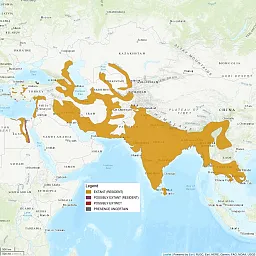
Jungle cat in Raigarh, Chhattisgarh, India. © Vivek Kumar Patel · some rights reserved
Jungle Cat
Species Facts
Larger and lankier than domestic cats, the jungle cat has an unspotted coat that varies from reddish or sandy brown to tawny gray. Fine black tips on the guard hairs give this cat a speckled appearance. The face of the jungle cat is long and slim with a bright white muzzle. Long, rounded ears are set close together high on the head, with a small but distinct tuft of black hair inside each. The cat has a short tail. Like in most species of cats, adult males are larger and heavier than adult females.
- Scientific Designation: Felis chaus
- Endangered Status: Least Concern
- Lifespan: 14 years
- Body Length: 56-94 cm
- Shoulder Height: 40-50 cm
- Tail Length: 20-31 cm
Behavior
The jungle cat is an excellent swimmer and is not averse to getting wet. Not as strictly nocturnal in its habits as many cats, it often can be seen hunting during daylight hours. It hunts chiefly on the ground, capturing its prey with stealth using felid stalk and ambush techniques. The jungle cat also uses vertical arching leaps to capture birds and small rodents.

Species Distribution
The jungle cat has a fairly wide geographic distribution throughout the Middle East and Asia.
A more appropriate name for this cat is “swamp cat” or “reed cat,” since the species is usually not found in the dense jungle. Instead, it is more common in densely vegetated river valleys in grass, thick brush, riverine swamps, and reed beds. Throughout its range, the cat lives in a variety of habitats and conditions, suggesting that it is a very adaptable species. The species is usually found at elevations lower than 1,000 meters (3,200 feet).
Distribution map courtesy of IUCN (International Union for Conservation of Nature), compiled in 2020.

Jungle cat and cubs. Photo © Moinudheen · some rights reserved
Threats to the Jungle Cat
Unlike most cat species, the jungle cat has a stable population in the wild. Its rodent-catching abilities, wide habitat tolerance, and adaptability make it the most common of the small felids. In fact, the International Union for Conservation of Nature (IUCN) puts this species in its Least Concern (LC) category. The species does, however, face pressure from retaliatory killing by farmers, hunting for its skin, and from habitat loss and destruction. The jungle cat is protected by the Convention on International Trade in Endangered Species (CITES) under appendix II.
Want to help us research and conserve this species?
Felidae Conservation Fund helps researchers around the world study and protect felids of all sizes.
Make sure you write a comment with "Jungle Cat" so we can designate 100% of your donation to go to protecting this species.
Do You Have 2-4 Hours A Month To Preserve Your Local Ecosystem?
Our volunteers are the driving force behind making true change in ecosystem health and wild cat conservation. Some like to volunteer in the field, others help us maintain our online presence, and some work with events. With just a few hours a month, you can make a difference, too.
Make A Difference Right Now
As a 501(c)3 nonprofit, our work is only possible because of generous donors like you.
More than 90% of your donation will go directly to our groundbreaking research, outreach, and education programs.
This is where true change starts. If you’d like to be a part of it, make a donation to Felidae Conservation Fund today:
Or,
